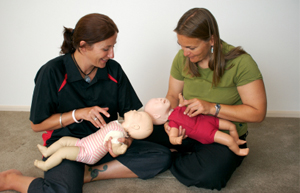Child minding can be a very rewarding experience as you probably enjoy being around kids and are getting paid for your help. But it is also a big responsibility. You are in charge of the safety of the children’s little lives whilst their parents are away and, should anything go wrong, you need to know what to do in the case of an emergency. So if your worst nightmare becomes a reality and the child you are caring for starts choking what should you do?
How do You Know the Child is Choking?
Choking can be life-threatening so it is crucial to be able to spot the signs of choking immediately. A child may be choking if they cannot breathe properly and are gasping for air. The child may begin to turn blue in the lips and face, or they may be unable to cry or talk.
A child may begin to choke on food or toys with small parts, particularly children under the age of four. Wikipedia states that –This type of choking is often suffered by small children, who are unable to appreciate the hazard inherent in putting small objects in their mouth. To help prevent choking do not feed children under four years old hard sweets, nuts or any small hard food that could easily get lodged in the throat.
What to do if a Child is Choking
If the child is over the age of 1, then try the following techniques:
- If you can see the foreign object then carefully try to remove it. Take care not to push it further down and cause more harm.
- Encourage the child to keep coughing as this can dislodge the object.
- If the coughing does not work start performing back blows. Place the child across your lap, face down, as you would a baby. If the child is too big then support the child leaning forwards as you give the back blows.
- If this does not dislodge the foreign object then begin abdominal thrusts. Position yourself behind the child and place your arms under the child’s arms and then around the child’s upper abdomen.
- Clench your fist and place it between the child’s belly button and their ribs.
- Take hold of your fist with your other hand and pull inwards and upwards sharply.
- Repeat the abdominal thrusts 5 times.
If after repeating the procedure 5 times you have still not managed to dislodge the foreign object then call the emergency services. Do not leave the child unattended. If at anytime the child becomes unconscious then you will have to begin CPR. Even if you do manage to dislodge the object call for professional medical help just in case some part of the object is left behind or the child has been hurt.
Taking care of children is serious business and the above information is no substitute for getting professional paediatric first aid training. Lebreton Training strongly recommend – that anyone responsible for the care of children seeks training in paediatric first aid techniques. If a first aiders techniques are poor or are not performed correctly then they could cause the child more harm than good.
By learning how to administer first aid to children correctly you could not only effectively help them when they injure themselves but you could also save their lives. Being a good child minder means learning how to deal with a number of different types of accidents such as burns, bleeding and broken bones. Paediatric first aid training will give you hands on experience in how to help a child that is choking and how to perform first aid techniques such as CPR which may prove vital in the future.
[toggle title=”Featured images”]
 License: Royalty Free or iStock source: http://www.istockphoto.com/
License: Royalty Free or iStock source: http://www.istockphoto.com/
[/toggle]
Ross Davies writes extensively about first aid training and in particular first aid for children. Ross lives in the UK with his wife and two children and is an avid blogger in the training and childcare industries. He enjoys social media and reading science fiction.

Leave a Reply